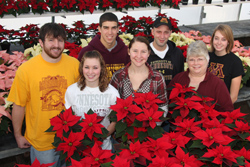 Hundreds of rooted poinsettia cuttings arrive in August in anticipation of another holiday season. For six students involved in the commercial floriculture class at the University of Minnesota, Crookston, those cuttings have developed into a beautiful poinsettia crop under their skill and coaxing.
Hundreds of rooted poinsettia cuttings arrive in August in anticipation of another holiday season. For six students involved in the commercial floriculture class at the University of Minnesota, Crookston, those cuttings have developed into a beautiful poinsettia crop under their skill and coaxing.This year's poinsettias create a beautiful and colorful display including Red, Peppermint, and Creamy White poinsettias along with a new one for this year called Ice Punch.
In the photo are members of the fall semester class including: back row (l to r): Tim Butson, Platteville, Wis.; Teddy Gutman, Burlington, Iowa; Steve Freeman, White Bear Lake, Minn.; and Kristine Neu, Pelican Rapids, Minn. Front row: Jada Ellenberg, Perham, Minn.; Stepheni Tietje, Kasson, Minn.; and U of M, Crookston Horticulture Instructor Sue Jacobson.
The students started the process of forcing the plants to bloom in time for the holiday season in October. Following a specific procedure to control the light, the students covered the plants with a dark cloth at 4 p.m. and uncovered them at 8 a.m. each day to regulate the length of daylight the plants receive. The students are responsible for greenhouse chores on the weekends as well. Although the class is taught by Jacobson, the crop is in the hands of the students. The work and production of the poinsettia crop is entirely the responsibility of the class.
The Agriculture and Natural Resources Department offers commercial floriculture as part of the horticulture program to acquaint students with producing plants for a specific date - a skill necessary for employment in a greenhouse or garden center. "Poinsettias form their colored "flowers" only if the length of days and nights are carefully regulated," explains Jacobson. "The poinsettia really doesn't have a bloom like most flowers. Instead, the colorful red, pink, or white petals are modified leaves known as bracts. The blooms are actually the small yellowish clusters in the center."
Jacobson often allows problems to develop to see how the students will solve them--something they would have to do in an employment situation and giving them an opportunity to apply what they have learned. The class demands hard work, dedication, and a strong team effort to grow the best poinsettias. Leadership and responsibility are two of the qualities that develop in this type of teaching and learning environment.
"Students learn so much from applying their classroom learning to real-world experience," Jacobson explains. "By taking responsibility for the crop, the students are accountable for the outcome making the commercial floriculture class one of the most memorable for the students." The class is excellent training for a career in horticulture, a multi-billion dollar industry in the U.S. To learn more about the horticulture program with emphases in environmental landscaping, production horticulture or urban forestry, visit www.UMCrookston.edu/academics.
Today the University of Minnesota, Crookston delivers more than 25 applied-science undergraduate degree programs and 50 concentrations, including several online degrees, in agriculture; arts, humanities and social sciences; business; math, science and technology; and natural resources. To learn more, visit www.UMCrookston.edu.
Contact: Sue Jacobson, horticulture instructor, 218-281-8118 (sjacobso@umn.edu) ;Elizabeth Tollefson, assistant director, communications, 218-281-8432 (ltollefs@umn.edu)

